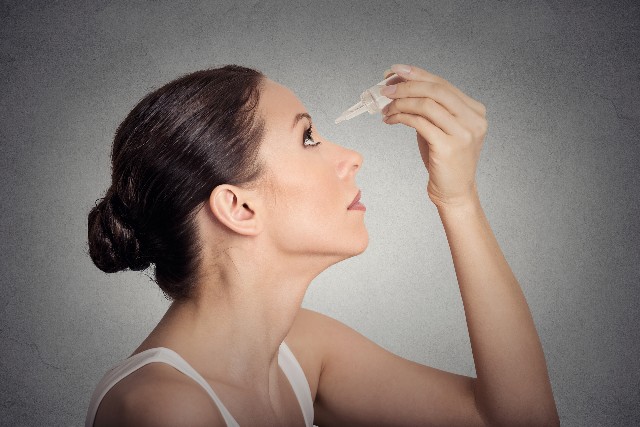Do you suffer from dry eyes? If so, you’re not alone. Roughly 16 million Americans have dry eyes. Some of them don’t even realize it.
In this blog post, we’ll explain the most common causes of dry eyes and treatments for dry eyes. That way, you can start feeling better right away! Keep reading to learn more about how to treat your dry, itchy eyes.
Managing Dry Eyes
Dry eyes are a common problem that’s caused by various factors, such as environmental conditions, age, and medications. Fortunately, there are a number of treatments available that can help relieve the symptoms of dry eyes.
The most common treatment for dry eyes is over-the-counter artificial tears. These drops help lubricate the eyes and can provide relief from the symptoms of dry eyes. In some cases, prescription medications may also be necessary to treat the condition.
There are a number of things you can do to help prevent or reduce the symptoms of dry eyes. Some tips include:
- using a humidifier to increase humidity levels in your home or office
- avoiding excessive wind or sun exposure
- closing your eyelids for a few seconds when you first wake up in the morning
- drinking plenty of water
- avoiding caffeine and alcohol
- using a computer with an LCD screen
- blinking regularly
If you’re experiencing symptoms of dry eyes, it’s important to see your doctor for diagnosis and treatment. Untreated dry eyes can lead to other problems, such as eye infections and corneal damage.
Causes of Dry Eyes
Dry eyes are a common problem that can cause eye irritation, redness, and blurred vision. While dry eyes are a nuisance, they can also be a sign of a more serious problem. In some cases, dry eyes may be a result of an underlying health condition.
There are many causes of dry eyes, including:
Aging
Aging is one of the primary causes of dry eyes. As we age, our eyes produce fewer tears.
As a result, mature adults notice a change in their eyes. A lack of lubrication could lead to mild discomfort.
Hormonal Changes
Hormonal changes can also cause dry eyes. For women, hormonal changes triggered by pregnancy, menopause, and birth control pills can lead to dry eyes. Managing dry eyes is more difficult when the root cause is hormonal.
However, there are dry eye treatments out there that can help.
Medical Conditions
Many medical conditions can create dry eyes, including rheumatoid arthritis, lupus, thyroid problems, and Sjogren’s syndrome. These types of conditions are harsh on the body.
When you’re experiencing one of these illnesses, it’s best to manage the root cause and implement treatments for dry eyes.
Sitting in Front of a Computer for Long Periods of Time
People who work on computers or read for long periods of time are at risk of developing dry eyes. This is because when we stare at a screen, we don’t blink as often as we do when looking at objects in the real world. This causes our eyes to become drier.
Thankfully, there are ways to prevent or treat dry eyes if you’re someone who sits in front of a computer all day long. Always look away from the screen every few minutes for about 20 seconds, and make sure that you blink!
Environmental Factors
Dry eyes can also be caused by environmental factors, such as smoke, wind, and sun exposure. These elements can cause our eyes to become irritated and inflamed.
If you’re susceptible to dry eyes, it’s important to take precautions against environmental factors that could make the condition worse.
There are many causes of dry eyes and managing them can be difficult. However, there are treatments available for all causes of this problem. If you’re experiencing dry eyes, don’t hesitate to talk to your doctor about the best way to treat them.
How to Treat Dry Eyes
There are several effective treatments for dry eyes. Here are just a few of them:
Artificial Tears
Artificial tears help to lubricate the eyes and keep them moist. They can be bought over-the-counter or prescribed by your doctor. They’re very effective for managing dry eyes.
Punctal Plugs
If you have dry eyes, your doctor may recommend punctal plugs. These are small devices that are inserted into the tear ducts to help keep your tears flowing. This option is generally recommended to those who experience severe dry eyes.
Lubricating Eye Drops
Lubricating eye drops help to hydrate and lubricate the eyes. They can also be bought over-the-counter or prescribed by your doctor. If you experience mild dry eyes from to time, lubricating eye drops should work just fine.
Restasis
Restasis is a prescription medication that helps to increase tear production. It is available from your physician. If you’re not comfortable with the idea of using a punctal plug, then Restasis is the next best option.
Omega-3 Supplements
Omega-3 supplements are a good option for people with dry eyes. They help to lubricate the eyes and keep them moist. You can find omega-3 supplements at most pharmacies or health food stores.
If you’re experiencing dry eyes, it’s important to seek treatment. There are several effective treatments available, so there’s sure to be one that’s right for you. Talk to your doctor about the best treatment for your dry eyes.
If you’re looking for additional ways to soothe your dry eyes, visit mycorneacare.com.
Why Are My Eyes So Dry? Treatments for Dry Eyes
As you can see, there are several treatments for dry eyes. Yes, dry eyes are a nuisance. But the good news is, that they’re common. Therefore, there are an abundance of treatments that’ll make your eyes feel better.
We hope this article was helpful. If it was, don’t hesitate to continue browsing our website. Thanks for reading our content.
